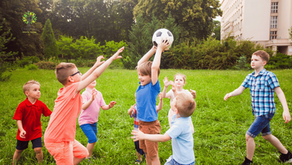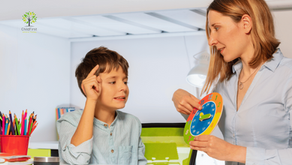Strengthening Bonds Through Parent-Child Yoga For Kids With Autism
- ChildFirst Behavior Therapy

- Dec 27, 2023
- 6 min read

In recent years, the therapeutic benefits of yoga for kids with autism spectrum disorder (ASD) have gained considerable attention. Amidst various approaches aiming to improve the lives of those with ASD, parent-child yoga stands out as an increasingly popular and effective method. It helps children on the spectrum develop physical strength and flexibility, fosters emotional regulation, and strengthens the bond between parent and child.
The Role of Yoga in Supporting Kids with Autism
Yoga, emphasizing breathing techniques, mindfulness, and gentle physical movements, offers a supportive environment for children with ASD, complementing ABA treatment for autism. The structured yet adaptable nature of yoga sessions can cater to their distinct needs and preferences. The advantages extend beyond physical health, encompassing mental and emotional well-being.
Parent-Child Yoga: A Holistic Approach
The concept of parent-child yoga involves both parent and child actively participating in yoga sessions together. In the context of ASD, this approach offers a powerful means of strengthening the bond between parent and child while providing a safe and supportive space for the child's development.
Building Trust and Connection
Yoga sessions allow parents and their children to engage in a shared activity that promotes trust and connection. The non-verbal nature of yoga allows for communication through movement, fostering a more profound understanding between parent and child. This shared experience can enhance the child's sense of security and attachment, contributing to their emotional development.
Encouraging Emotional Regulation
Children with ASD often face challenges in regulating their emotions. The mindfulness and breathing techniques taught in yoga help them develop self-awareness and self-regulation skills. Children learn to manage their emotions and stress levels through gentle movements and focused breathing, leading to a calmer state of mind.
Enhancing Physical and awareness
Yoga poses focus on body awareness and control, which can be particularly beneficial for children with receptive sensitivities. The repetitive movements in yoga help improve coordination and motor skills, contributing to better body awareness and control. Additionally, yoga provides a structured environment that can assist in managing receptive overload, helping children adapt and cope with different sensations.
Practical Tips for Parent-Kids Yoga Sessions
Create a Comfortable Environment: Ensure the yoga space is free from distractions and provides a calming atmosphere.
Use Visual Aids and Simplified Instructions: Visual aids and simple instructions aid comprehension and engagement.
Embrace Flexibility: Adapt yoga poses and activities to suit the child's comfort level and needs.
Focus on Fun and Connection: Encourage playfulness and bonding moments during the session.
Challenges and Rewards
Implementing parent-child yoga with kids may present challenges, including varying levels of engagement and receptive sensitivities. However, the rewards outweigh these challenges. The shared experience of parent-child yoga benefits the child and empowers parents by strengthening their relationship with their child and providing them with tools to support their development.
The Power of Mindfulness in Parent-Child Yoga
One of the cornerstones of yoga practice is mindfulness, the art of being present in the moment. For children on the autism spectrum, who may often struggle with receptive overload and rapid attention shifts, cultivating mindfulness can be transformative. In parent-child yoga sessions, mindfulness is gently introduced through breathing exercises and guided meditation. These practices encourage both parent and child to focus on the present moment, letting go of distractions and worries.
For children with ASD, this is especially valuable as it helps them develop attentional control and emotional regulation. Mindfulness exercises within yoga promote a sense of calmness and relaxation.
By modeling these practices, parents can demonstrate and encourage their children to manage stress and anxiety effectively. The benefits extend beyond the yoga session, empowering children to incorporate mindfulness into their daily lives.
Strengthening Communication and Social Skills
Communication and social interaction pose significant challenges for children with ASD. Through its non-verbal and interactive nature, parent-child yoga provides a platform for improving these skills in a supportive setting. Parents and children engage in joint activities during yoga sessions, fostering interaction and communication.
Children on the spectrum learn valuable social cues and communication skills by mirroring movements and maintaining eye contact. These non-verbal interactions can serve as a stepping stone for improving their ability to connect and communicate with others. Furthermore, the shared experience of parent-child yoga creates a bond that encourages open communication. Parents can use this opportunity to observe and understand their child's cues and responses, fostering a deeper connection and building a foundation for effective communication outside the yoga session.
Tailoring Yoga for Individual Needs
Every child with ASD is unique, and their preferences and needs vary. Parent-child yoga allows flexibility in adapting yoga practices to suit each child's needs. Some children enjoy more dynamic movements, while others prefer gentler, calming activities. Attention to the child's preferences and comfort level is crucial in creating a positive yoga experience. Additionally, modifying yoga poses or incorporating receptive tools like props or textures can cater to their specific receptive sensitivities, ensuring a more inclusive and beneficial session.
Overcoming Challenges Through Patience and Consistency
Implementing parent-child yoga with Autism children may not always be smooth sailing. Some sessions might be met with resistance or a need for more engagement. Patience and consistency are crucial to overcoming these challenges. Parents and instructors should approach each session with an open mind and a patient attitude. It's essential to acknowledge and accept the child's responses without judgment. Consistency in yoga sessions helps build familiarity and comfort, gradually increasing the child's participation and enjoyment.
The Lasting Impact of Parent-Child Yoga

The impact of parent-child yoga extends far beyond the yoga mat. It lays the foundation for a lifelong practice that promotes physical health, emotional well-being, and stronger family bonds.
As children on the autism spectrum grow and develop, the skills and connections forged through parent-child yoga serve as a valuable resource. The mindfulness, communication skills, and emotional regulation cultivated during these sessions become integral parts of their toolkits for navigating the complexities of daily life. Moreover, parent-child yoga fosters a sense of togetherness and mutual understanding within the family. It encourages parents to engage with their children in a positive, supportive environment, strengthening the family dynamic.
Conclusion
Parent-child yoga stands as a beacon of hope and growth for families navigating the challenges of autism. Its holistic approach empowers both parent and child, fostering emotional connection, enhancing well-being, and promoting personal growth. By embracing mindfulness, communication, and tailored practices, parent-child yoga nurtures the potential for a brighter and more connected future for children with autism and their families.
To embark on this transformative journey and explore parent-child yoga further:
Reach out to ChildFirst Behavior Therapy.
Contact us here to discover how parent-child yoga can enrich the lives of your family and strengthen the bonds that matter most.
Start today and pave the way for a more fulfilling tomorrow.
FAQs
Is yoga suitable for all kids with autism?
Yoga can be beneficial for many children with autism, but individual preferences and sensitivities vary. It's essential to introduce yoga in a way that suits the child's comfort level and needs. Some children might adjust to the practice, while others may immediately engage and enjoy it.
How can I prepare my child for a yoga session?
Preparing your child for a yoga session involves creating a comfortable environment and setting clear expectations. You can introduce the idea of yoga positively by discussing it beforehand, using visual aids, or showing videos of simple yoga poses to generate interest and familiarity.
What if my child has receptive sensitivities or difficulties with specific movements?
Yoga can be adapted to accommodate receptive sensitivities or motor difficulties. Consider using props like blankets, cushions, or textured mats to provide comfort during poses. Modifying movements or offering alternative poses can cater to specific needs while reaping yoga's benefits.
How can I encourage my child's participation in parent-child yoga?
Encouraging participation involves creating a supportive and engaging atmosphere. Use positive reinforcement, maintain a playful approach, and follow your child's lead. Incorporating activities they enjoy or offering choices within the session can enhance their involvement.
What if my child has difficulty with attention and focus during yoga?
Children with autism may struggle with attention and focus. Shortening the duration of the session, breaking it into smaller segments, or incorporating activities that encourage movement can help maintain their engagement. Consistency and gradual progress are vital in building attention span over time.
How can I continue the benefits of parent-child yoga at home?
Integrating simple yoga practices into daily routines at home can extend the benefits of parent-child yoga. Encourage breathing exercises before bedtime, incorporate mindful moments during the day, or engage in brief yoga sessions together regularly to reinforce the skills learned during formal sessions.
How do I find a suitable parent-child yoga instructor or program?
Look for instructors or programs with experience or specific training in working with Autism children. Consider their approach, understanding of individual needs, and willingness to adapt yoga practices. Recommendations from other families or professionals in the field can also be valuable.
What if my child initially resists or doesn't enjoy yoga?
It's common for children to take time to warm up to new activities. Be patient and persistent while introducing yoga. Starting with shorter sessions, gradually increasing duration, and exploring different approaches or styles of yoga might help find what resonates best with your child.
Can parent-child yoga replace other therapies or interventions for autism?
Parent-child yoga can be a valuable addition to other therapies and interventions but might only partially replace them. It complements different approaches by offering a holistic practice that supports emotional regulation, and family bonding, contributing to a well-rounded therapeutic plan.










Comments